Precision in Brief: The Bayesian Hurst–Kolmogorov Method for the Assessment of Long-Range Temporal Correlations in Short Behavioral Time Series
Abstract
1. Introduction
- Additive white Gaussian noise (awGn). awGn is the most common contaminant in physiological records. Sometimes, awGn might occur due to inaccuracies in the measurement equipment—for instance, when recording electromyography [74,75] or an electrocardiogram in an intensive care unit [76]. At other times, awGn can be inherent in the measured system itself—for instance, the cardiac system [77,78], in which case the presence of awGn can be informative about the system’s condition, e.g., to detect arterial fibrillation [78,79].
- Fractional Gaussian noise (fGn). Although a less common contaminant than awGn, fGn often corrupts physiological signals. Sources of this contaminant often include similar systems; for instance, speech recordings of one person often become corrupted by fGn from surrounding speakers or echo from the same person’s speech [80,81].
- Short-range correlations. Temperature records constitute the most prominent and intuitive examples of measurements contaminated with short-range correlations characterized by strong persistence at the timescale of a few (usually ) days superimposed on the long-range temporal correlations inherent in variability in weather conditions [82,83,84]. In the behavioral sciences, fractal fluctuations rarely appear in isolation in empirical time series and could be contaminated with various short-range correlated processes [85,86,87].
- Trends. Again, temperature records provide a convenient example of measurements contaminated with trends [88]. Due to experimental constraints, fatigue, etc., trends also ubiquitously contaminate behavioral measurements [89]. For instance, the stride length gradually increases or decreases along with long-range temporal correlations when a person starts or stops, respectively, walking on a treadmill, and the reaction time might increase due to increasing cognitive fatigue.
2. Theoretical Background
2.1. Estimating the Hurst Exponent Using the HK Method
2.2. Estimating the Hurst Exponent Using DFA
2.3. The Effects of Additive White Gaussian Noise
2.4. The Effects of fGn
2.5. The Effects of Short-Range Correlations
2.6. The Effects of Cyclical Trends
2.7. The Effects of Linear Trends
2.8. The Effects of Quadratic Trends
2.9. When to Use the HK Process and First- and Second-Order DFA
3. Discussion
Author Contributions
Funding
Institutional Review Board Statement
Data Availability Statement
Conflicts of Interest
Appendix A. Code Snippet for the Estimation of the Bayesian Hurst Exponent Using the HK Method in R
| Listing A1. R code snippet for estimation of the Bayesian Hurst exponent of a time series. |
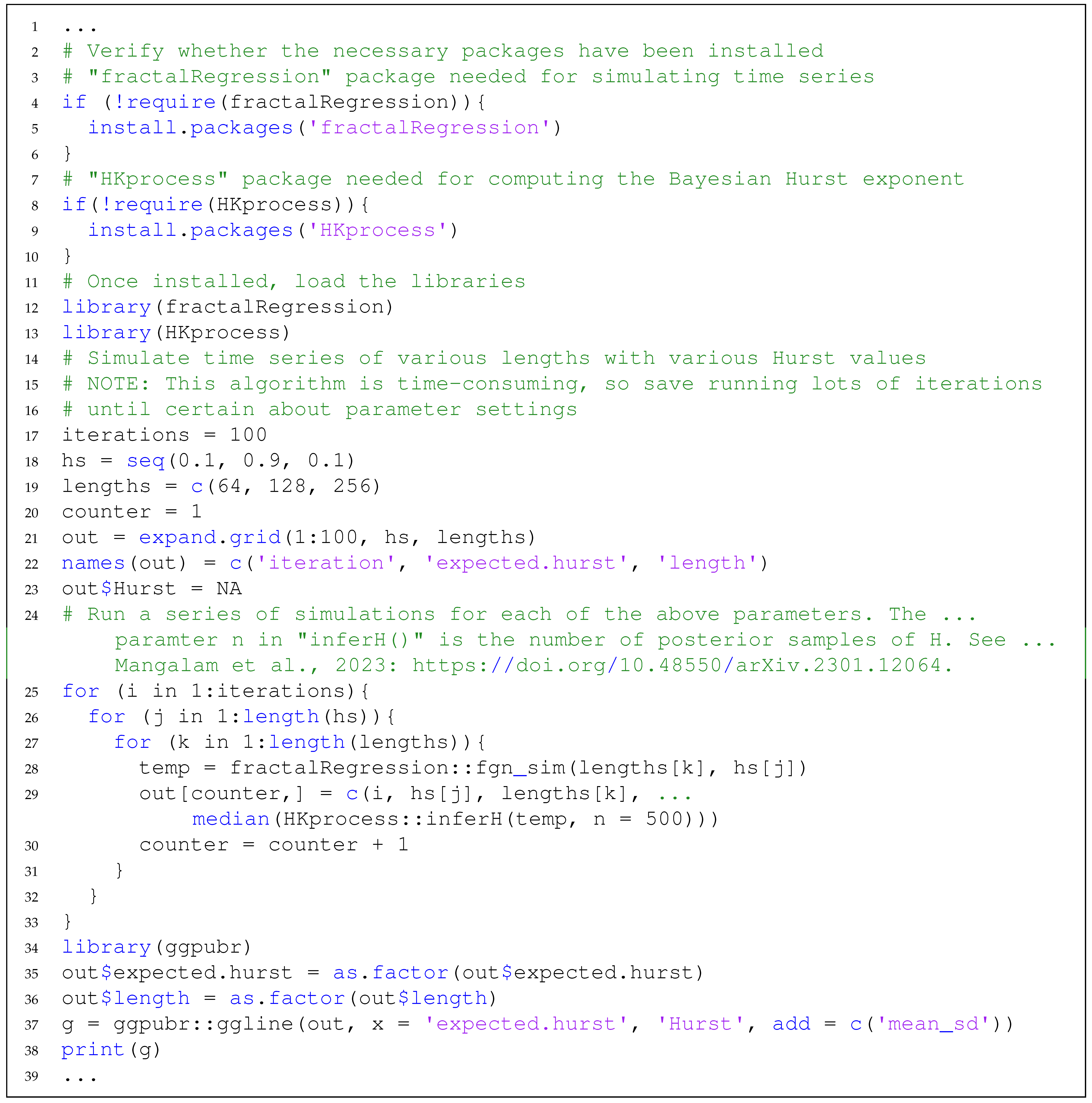 |
References
- Hurst, H.E. Long-term storage capacity of reservoirs. Trans. Am. Soc. Civ. Eng. 1951, 116, 770–799. [Google Scholar] [CrossRef]
- Mandelbrot, B.B.; Wallis, J.R. Computer experiments with fractional Gaussian noises: Part 1, averages and variances. Water Resour. Res. 1969, 5, 228–241. [Google Scholar] [CrossRef]
- Efstathiou, M.; Varotsos, C. On the altitude dependence of the temperature scaling behaviour at the global troposphere. Int. J. Remote Sens. 2010, 31, 343–349. [Google Scholar] [CrossRef]
- Ivanova, K.; Ausloos, M. Application of the detrended fluctuation analysis (DFA) method for describing cloud breaking. Phys. A Stat. Mech. Its Appl. 1999, 274, 349–354. [Google Scholar] [CrossRef]
- Tatli, H.; Dalfes, H.N. Long-time memory in drought via detrended fluctuation analysis. Water Resour. Manag. 2020, 34, 1199–1212. [Google Scholar] [CrossRef]
- Alvarez-Ramirez, J.; Alvarez, J.; Rodriguez, E. Short-term predictability of crude oil markets: A detrended fluctuation analysis approach. Energy Econ. 2008, 30, 2645–2656. [Google Scholar] [CrossRef]
- Grau-Carles, P. Empirical evidence of long-range correlations in stock returns. Phys. A Stat. Mech. Its Appl. 2000, 287, 396–404. [Google Scholar] [CrossRef]
- Ivanov, P.C.; Yuen, A.; Podobnik, B.; Lee, Y. Common scaling patterns in intertrade times of US stocks. Phys. Rev. E 2004, 69, 056107. [Google Scholar] [CrossRef]
- Liu, Y.; Cizeau, P.; Meyer, M.; Peng, C.-K.; Stanley, H.E. Correlations in economic time series. Phys. A Stat. Mech. Its Appl. 1997, 245, 437–440. [Google Scholar] [CrossRef]
- Liu, Y.; Gopikrishnan, P.; Stanley, H.E. Statistical properties of the volatility of price fluctuations. Phys. Rev. E 1999, 60, 1390. [Google Scholar] [CrossRef]
- Alados, C.L.; Huffman, M.A. Fractal long-range correlations in behavioural sequences of wild chimpanzees: A non-invasive analytical tool for the evaluation of health. Ethology 2000, 106, 105–116. [Google Scholar] [CrossRef]
- Bee, M.A.; Kozich, C.E.; Blackwell, K.J.; Gerhardt, H.C. Individual variation in advertisement calls of territorial male green frogs, Rana clamitans: Implications for individual discrimination. Ethology 2001, 107, 65–84. [Google Scholar] [CrossRef]
- Buldyrev, S.; Dokholyan, N.; Goldberger, A.; Havlin, S.; Peng, C.-K.; Stanley, H.; Viswanathan, G. Analysis of DNA sequences using methods of statistical physics. Phys. A Stat. Mech. Its Appl. 1998, 249, 430–438. [Google Scholar] [CrossRef]
- Mantegna, R.N.; Buldyrev, S.V.; Goldberger, A.L.; Havlin, S.; Peng, C.-K.; Simons, M.; Stanley, H.E. Linguistic features of noncoding DNA sequences. Phys. Rev. Lett. 1994, 73, 3169. [Google Scholar] [CrossRef]
- Peng, C.-K.; Buldyrev, S.; Goldberger, A.; Havlin, S.; Simons, M.; Stanley, H. Finite-size effects on long-range correlations: Implications for analyzing DNA sequences. Phys. Rev. E 1993, 47, 3730. [Google Scholar] [CrossRef]
- Castiglioni, P.; Faini, A. A fast DFA algorithm for multifractal multiscale analysis of physiological time series. Front. Physiol. 2019, 10, 115. [Google Scholar] [CrossRef] [PubMed]
- Goldberger, A.L.; Amaral, L.A.; Hausdorff, J.M.; Ivanov, P.C.; Peng, C.-K.; Stanley, H.E. Fractal dynamics in physiology: Alterations with disease and aging. Proc. Natl. Acad. Sci. USA 2002, 99, 2466–2472. [Google Scholar] [CrossRef] [PubMed]
- Hardstone, R.; Poil, S.-S.; Schiavone, G.; Jansen, R.; Nikulin, V.V.; Mansvelder, H.D.; Linkenkaer-Hansen, K. Detrended fluctuation analysis: A scale-free view on neuronal oscillations. Front. Physiol. 2012, 3, 450. [Google Scholar] [CrossRef]
- Peng, C.-K.; Mietus, J.; Hausdorff, J.; Havlin, S.; Stanley, H.E.; Goldberger, A.L. Long-range anticorrelations and non-Gaussian behavior of the heartbeat. Phys. Rev. Lett. 1993, 70, 1343. [Google Scholar] [CrossRef]
- Delignières, D.; Torre, K.; Bernard, P.-L. Transition from persistent to anti-persistent correlations in postural sway indicates velocity-based control. PLoS Comput. Biol. 2011, 7, e1001089. [Google Scholar] [CrossRef]
- Duarte, M.; Sternad, D. Complexity of human postural control in young and older adults during prolonged standing. Exp. Brain Res. 2008, 191, 265–276. [Google Scholar] [CrossRef] [PubMed]
- Lin, D.; Seol, H.; Nussbaum, M.A.; Madigan, M.L. Reliability of COP-based postural sway measures and age-related differences. Gait Posture 2008, 28, 337–342. [Google Scholar] [CrossRef] [PubMed]
- Chen, Y.; Ding, M.; Kelso, J.S. Long memory processes (1/fα type) in human coordination. Phys. Rev. Lett. 1997, 79, 4501. [Google Scholar] [CrossRef]
- Diniz, A.; Wijnants, M.L.; Torre, K.; Barreiros, J.; Crato, N.; Bosman, A.M.; Hasselman, F.; Cox, R.F.; Van Orden, G.C.; Delignières, D. Contemporary theories of 1/f noise in motor control. Hum. Mov. Sci. 2011, 30, 889–905. [Google Scholar] [CrossRef] [PubMed]
- Allegrini, P.; Menicucci, D.; Bedini, R.; Fronzoni, L.; Gemignani, A.; Grigolini, P.; West, B.J.; Paradisi, P. Spontaneous brain activity as a source of ideal 1/f noise. Phys. Rev. E 2009, 80, 061914. [Google Scholar] [CrossRef]
- Gilden, D.L.; Thornton, T.; Mallon, M.W. 1/f noise in human cognition. Science 1995, 267, 1837–1839. [Google Scholar] [CrossRef]
- Kello, C.T.; Brown, G.D.; Ferrer-i Cancho, R.; Holden, J.G.; Linkenkaer-Hansen, K.; Rhodes, T.; Van Orden, G.C. Scaling laws in cognitive sciences. Trends Cogn. Sci. 2010, 14, 223–232. [Google Scholar] [CrossRef]
- Stephen, D.G.; Stepp, N.; Dixon, J.A.; Turvey, M. Strong anticipation: Sensitivity to long-range correlations in synchronization behavior. Phys. A Stat. Mech. Its Appl. 2008, 387, 5271–5278. [Google Scholar] [CrossRef]
- Van Orden, G.C.; Holden, J.G.; Turvey, M.T. Self-organization of cognitive performance. J. Exp. Psychol. Gen. 2003, 132, 331–350. [Google Scholar] [CrossRef]
- Mangalam, M.; Conners, J.D.; Kelty-Stephen, D.G.; Singh, T. Fractal fluctuations in muscular activity contribute to judgments of length but not heaviness via dynamic touch. Exp. Brain Res. 2019, 237, 1213–1226. [Google Scholar] [CrossRef]
- Mangalam, M.; Chen, R.; McHugh, T.R.; Singh, T.; Kelty-Stephen, D.G. Bodywide fluctuations support manual exploration: Fractal fluctuations in posture predict perception of heaviness and length via effortful touch by the hand. Hum. Mov. Sci. 2020, 69, 102543. [Google Scholar] [CrossRef] [PubMed]
- Mangalam, M.; Carver, N.S.; Kelty-Stephen, D.G. Global broadcasting of local fractal fluctuations in a bodywide distributed system supports perception via effortful touch. Chaos Solitons Fractals 2020, 135, 109740. [Google Scholar] [CrossRef]
- Ashkenazy, Y.; Lewkowicz, M.; Levitan, J.; Havlin, S.; Saermark, K.; Moelgaard, H.; Thomsen, P.B. Discrimination between healthy and sick cardiac autonomic nervous system by detrended heart rate variability analysis. Fractals 1999, 7, 85–91. [Google Scholar] [CrossRef]
- Ho, K.K.; Moody, G.B.; Peng, C.-K.; Mietus, J.E.; Larson, M.G.; Levy, D.; Goldberger, A.L. Predicting survival in heart failure case and control subjects by use of fully automated methods for deriving nonlinear and conventional indices of heart rate dynamics. Circulation 1997, 96, 842–848. [Google Scholar] [CrossRef] [PubMed]
- Peng, C.-K.; Havlin, S.; Hausdorff, J.; Mietus, J.; Stanley, H.; Goldberger, A. Fractal mechanisms and heart rate dynamics: Long-range correlations and their breakdown with disease. J. Electrocardiol. 1995, 28, 59–65. [Google Scholar] [CrossRef]
- Bartsch, R.; Plotnik, M.; Kantelhardt, J.W.; Havlin, S.; Giladi, N.; Hausdorff, J.M. Fluctuation and synchronization of gait intervals and gait force profiles distinguish stages of Parkinson’s disease. Phys. A Stat. Mech. Its Appl. 2007, 383, 455–465. [Google Scholar] [CrossRef] [PubMed]
- Hausdorff, J.M.; Mitchell, S.L.; Firtion, R.; Peng, C.-K.; Cudkowicz, M.E.; Wei, J.Y.; Goldberger, A.L. Altered fractal dynamics of gait: Reduced stride-interval correlations with aging and Huntington’s disease. J. Appl. Physiol. 1997, 82, 262–269. [Google Scholar] [CrossRef]
- Hausdorff, J.M.; Ashkenazy, Y.; Peng, C.-K.; Ivanov, P.C.; Stanley, H.E.; Goldberger, A.L. When human walking becomes random walking: Fractal analysis and modeling of gait rhythm fluctuations. Phys. A Stat. Mech. Its Appl. 2001, 302, 138–147. [Google Scholar] [CrossRef]
- Hausdorff, J.M. Gait dynamics, fractals and falls: Finding meaning in the stride-to-stride fluctuations of human walking. Hum. Mov. Sci. 2007, 26, 555–589. [Google Scholar] [CrossRef]
- Herman, T.; Giladi, N.; Gurevich, T.; Hausdorff, J. Gait instability and fractal dynamics of older adults with a “cautious” gait: Why do certain older adults walk fearfully? Gait Posture 2005, 21, 178–185. [Google Scholar] [CrossRef]
- Kobsar, D.; Olson, C.; Paranjape, R.; Hadjistavropoulos, T.; Barden, J.M. Evaluation of age-related differences in the stride-to-stride fluctuations, regularity and symmetry of gait using a waist-mounted tri-axial accelerometer. Gait Posture 2014, 39, 553–557. [Google Scholar] [CrossRef] [PubMed]
- Kaipust, J.P.; McGrath, D.; Mukherjee, M.; Stergiou, N. Gait variability is altered in older adults when listening to auditory stimuli with differing temporal structures. Ann. Biomed. Eng. 2013, 41, 1595–1603. [Google Scholar] [CrossRef] [PubMed]
- Marmelat, V.; Duncan, A.; Meltz, S.; Meidinger, R.L.; Hellman, A.M. Fractal auditory stimulation has greater benefit for people with Parkinson’s disease showing more random gait pattern. Gait Posture 2020, 80, 234–239. [Google Scholar] [CrossRef] [PubMed]
- Vaz, J.R.; Knarr, B.A.; Stergiou, N. Gait complexity is acutely restored in older adults when walking to a fractal-like visual stimulus. Hum. Mov. Sci. 2020, 74, 102677. [Google Scholar] [CrossRef] [PubMed]
- Carpena, P.; Coronado, A.V. On the autocorrelation function of 1/f noises. Mathematics 2022, 10, 1416. [Google Scholar] [CrossRef]
- Combs, A.; Winkler, M.; Daley, C. A chaotic systems analysis of rhythms in feeling states. Psychol. Rec. 1994, 44, 359–368. [Google Scholar] [CrossRef]
- De Ruiter, N.M.; Den Hartigh, R.J.; Cox, R.F.; Van Geert, P.L.; Kunnen, E.S. The temporal structure of state self-esteem variability during parent–adolescent interactions: More than random fluctuations. Self Identity 2015, 14, 314–333. [Google Scholar] [CrossRef]
- Heath, R.A.; Heiby, E.M.; Pagano, I.S. Complex dynamics in depression: An application to long-term, mood-rating time series. In Advances in Clinical Cognitive Science: Formal Modeling of Processes and Symptoms; Neufeld, R.W., Ed.; American Psychological Association: Washington, DC, USA, 2007; pp. 263–291. [Google Scholar]
- Heino, M.T.; Knittle, K.; Noone, C.; Hasselman, F.; Hankonen, N. Studying behaviour change mechanisms under complexity. Behav. Sci. 2021, 11, 77. [Google Scholar] [CrossRef]
- Olthof, M.; Hasselman, F.; Lichtwarck-Aschoff, A. Complexity in psychological self-ratings: Implications for research and practice. BMC Med. 2020, 18, 317. [Google Scholar] [CrossRef]
- Olthof, M.; Hasselman, F.; Aas, B.; Lamoth, D.; Scholz, S.; Daniels-Wredenhagen, N.; Goldbeck, F.; Weinans, E.; Strunk, G.; Schiepek, G.; et al. The best of both worlds? general principles of psychopathology in personalized assessment. J. Psychopathol. Clin. Sci. 2023, 132, 808–819. [Google Scholar] [CrossRef]
- Olthof, M.; Hasselman, F.; Oude Maatman, F.; Bosman, A.M.; Lichtwarck-Aschoff, A. Complexity theory of psychopathology. J. Psychopathol. Clin. Sci. 2023, 132, 314–323. [Google Scholar] [CrossRef] [PubMed]
- Zanesco, A.P.; Denkova, E.; Jha, A.P. Examining long-range temporal dependence in experience sampling reports of mind wandering. Comput. Brain Behav. 2022, 5, 217–233. [Google Scholar] [CrossRef]
- Gottschalk, A.; Bauer, M.S.; Whybrow, P.C. Evidence of chaotic mood variation in bipolar disorder. Arch. Gen. Psychiatry 1995, 52, 947–959. [Google Scholar] [CrossRef] [PubMed]
- Delignières, D.; Fortes, M.; Ninot, G. The fractal dynamics of self-esteem and physical self. Nonlinear Dyn. Psychol. Life Sci. 2004, 8, 479–510. [Google Scholar]
- Snow, E.L.; Likens, A.D.; Allen, L.K.; McNamara, D.S. Taking control: Stealth assessment of deterministic behaviors within a game-based system. Int. J. Artif. Intell. Educ. 2016, 26, 1011–1032. [Google Scholar] [CrossRef]
- Peng, C.-K.; Buldyrev, S.V.; Havlin, S.; Simons, M.; Stanley, H.E.; Goldberger, A.L. Mosaic organization of DNA nucleotides. Phys. Rev. E 1994, 49, 1685. [Google Scholar] [CrossRef]
- Peng, C.-K.; Havlin, S.; Stanley, H.E.; Goldberger, A.L. Quantification of scaling exponents and crossover phenomena in nonstationary heartbeat time series. Chaos 1995, 5, 82–87. [Google Scholar] [CrossRef]
- Bashan, A.; Bartsch, R.; Kantelhardt, J.W.; Havlin, S. Comparison of detrending methods for fluctuation analysis. Phys. A Stat. Mech. Its Appl. 2008, 387, 5080–5090. [Google Scholar] [CrossRef]
- Grech, D.; Mazur, Z. Statistical properties of old and new techniques in detrended analysis of time series. Acta Phys. Pol. Ser. B 2005, 36, 2403. [Google Scholar]
- Coronado, A.V.; Carpena, P. Size effects on correlation measures. J. Biol. Phys. 2005, 31, 121–133. [Google Scholar] [CrossRef]
- Dlask, M.; Kukal, J. Hurst exponent estimation from short time series. Signal Image Video Process. 2019, 13, 263–269. [Google Scholar] [CrossRef]
- Katsev, S.; L’Heureux, I. Are Hurst exponents estimated from short or irregular time series meaningful? Comput. Geosci. 2003, 29, 1085–1089. [Google Scholar] [CrossRef]
- Schaefer, A.; Brach, J.S.; Perera, S.; Sejdić, E. A comparative analysis of spectral exponent estimation techniques for 1/fβ processes with applications to the analysis of stride interval time series. J. Neurosci. Methods 2014, 222, 118–130. [Google Scholar] [CrossRef]
- Almurad, Z.M.; Delignières, D. Evenly spacing in detrended fluctuation analysis. Phys. A Stat. Mech. Its Appl. 2016, 451, 63–69. [Google Scholar] [CrossRef]
- Delignieres, D.; Ramdani, S.; Lemoine, L.; Torre, K.; Fortes, M.; Ninot, G. Fractal analyses for ‘short’ time series: A re-assessment of classical methods. J. Math. Psychol. 2006, 50, 525–544. [Google Scholar] [CrossRef]
- Marmelat, V.; Meidinger, R.L. Fractal analysis of gait in people with Parkinson’s disease: Three minutes is not enough. Gait Posture 2019, 70, 229–234. [Google Scholar] [CrossRef]
- Ravi, D.K.; Marmelat, V.; Taylor, W.R.; Newell, K.M.; Stergiou, N.; Singh, N.B. Assessing the temporal organization of walking variability: A systematic review and consensus guidelines on detrended fluctuation analysis. Front. Physiol. 2020, 11, 562. [Google Scholar] [CrossRef] [PubMed]
- Roume, C.; Ezzina, S.; Blain, H.; Delignières, D. Biases in the simulation and analysis of fractal processes. Comput. Math. Methods Med. 2019, 2019, 4025305. [Google Scholar] [CrossRef]
- Yuan, Q.; Gu, C.; Weng, T.; Yang, H. Unbiased detrended fluctuation analysis: Long-range correlations in very short time series. Phys. A Stat. Mech. Its Appl. 2018, 505, 179–189. [Google Scholar] [CrossRef]
- Stroe-Kunold, E.; Stadnytska, T.; Werner, J.; Braun, S. Estimating long-range dependence in time series: An evaluation of estimators implemented in R. Behav. Res. Methods 2009, 41, 909–923. [Google Scholar] [CrossRef]
- Tyralis, H.; Koutsoyiannis, D. A Bayesian statistical model for deriving the predictive distribution of hydroclimatic variables. Clim. Dyn. 2014, 42, 2867–2883. [Google Scholar] [CrossRef]
- Likens, A.D.; Mangalam, M.; Wong, A.Y.; Charles, A.C.; Mill, C. Better than DFA? A Bayesian method for estimating the Hurst exponent in behavioral sciences. arXiv 2024, arXiv:2301.11262. [Google Scholar]
- Nolan, H.; Whelan, R.; Reilly, R.B. FASTER: Fully automated statistical thresholding for EEG artifact rejection. J. Neurosci. Methods 2010, 192, 152–162. [Google Scholar] [CrossRef] [PubMed]
- Zhang, X.; Zhou, P. Filtering of surface EMG using ensemble empirical mode decomposition. Med. Eng. Phys. 2013, 35, 537–542. [Google Scholar] [CrossRef] [PubMed]
- Li, Q.; Mark, R.G.; Clifford, G.D. Robust heart rate estimation from multiple asynchronous noisy sources using signal quality indices and a Kalman filter. Physiol. Meas. 2007, 29, 15. [Google Scholar] [CrossRef]
- Bogachev, M.I.; Kireenkov, I.S.; Nifontov, E.M.; Bunde, A. Statistics of return intervals between long heartbeat intervals and their usability for online prediction of disorders. New J. Phys. 2009, 11, 063036. [Google Scholar] [CrossRef]
- Hennig, T.; Maass, P.; Hayano, J.; Heinrichs, S. Exponential distribution of long heart beat intervals during atrial fibrillation and their relevance for white noise behaviour in power spectrum. J. Biol. Phys. 2006, 32, 383–392. [Google Scholar] [CrossRef] [PubMed]
- Hayano, J.; Yamasaki, F.; Sakata, S.; Okada, A.; Mukai, S.; Fujinami, T. Spectral characteristics of ventricular response to atrial fibrillation. Am. J.-Physiol.-Heart Circ. Physiol. 1997, 273, H2811–H2816. [Google Scholar] [CrossRef]
- Biscainho, L.W.; Esquef, P.A.; Freeland, F.P.; Nunes, L.O.; Tygel, A.F.; Lee, B.; Said, A.; Kalker, T.; Schafer, R.W. An objective method for quality assessment of ultra-wideband speech corrupted by echo. In Proceedings of the 2009 IEEE International Workshop on Multimedia Signal Processing, Rio De Janeiro, Brazil, 5–7 October 2009; IEEE: Piscataway, NJ, USA, 2009; pp. 1–6. [Google Scholar] [CrossRef]
- Ondusko, R.; Marbach, M.; McClellan, A.; Ramachandran, R.P.; Head, L.M.; Huggins, M.C.; Smolenski, B.Y. Blind determination of the signal to noise ratio of speech signals based on estimation combination of multiple features. In Proceedings of the APCCAS 2006—2006 IEEE Asia Pacific Conference on Circuits and Systems, Singapore, 4–7 December 2006; IEEE: Piscataway, NJ, USA, 2006; pp. 1895–1898. [Google Scholar] [CrossRef]
- Koscielny-Bunde, E.; Bunde, A.; Havlin, S.; Roman, H.E.; Goldreich, Y.; Schellnhuber, H.-J. Indication of a universal persistence law governing atmospheric variability. Phys. Rev. Lett. 1998, 81, 729. [Google Scholar] [CrossRef]
- Rybski, D.; Bunde, A.; Havlin, S.; Von Storch, H. Long-term persistence in climate and the detection problem. Geophys. Res. Lett. 2006, 33, L06718. [Google Scholar] [CrossRef]
- Rybski, D.; Bunde, A.; Havlin, S.; Kantelhardt, J.W.; Koscielny-Bunde, E. Detrended fluctuation studies of long-term persistence and multifractality of precipitation and river runoff records. In Extremis: Disruptive Events and Trends in Climate and Hydrology; Kropp, J., Schellnhuber, H.-J., Eds.; Springer: Berlin/Heidelberg, Germany, 2011; pp. 216–248. [Google Scholar] [CrossRef]
- Delignières, D.; Marmelat, V. Theoretical and methodological issues in serial correlation analysis. In Progress in Motor Control: Neural, Computational and Dynamic Approaches; Springer: New York, NY, USA, 2013; pp. 127–148. [Google Scholar] [CrossRef]
- Wagenmakers, E.-J.; Farrell, S.; Ratcliff, R. Estimation and interpretation of 1/fα noise in human cognition. Psychon. Bull. Rev. 2004, 11, 579–615. [Google Scholar] [CrossRef] [PubMed]
- Wagenmakers, E.-J.; Farrell, S.; Ratcliff, R. Human cognition and a pile of sand: A discussion on serial correlations and self-organized criticality. J. Exp. Psychol. Gen. 2005, 134, 108–116. [Google Scholar] [CrossRef] [PubMed]
- Livina, V.N.; Ashkenazy, Y.; Bunde, A.; Havlin, S. Seasonality effects on nonlinear properties of hydrometeorological records. In Extremis: Disruptive Events and Trends in Climate and Hydrology; Kropp, J., Schellnhuber, H.-J., Eds.; Springer: Berlin/Heidelberg, Germany, 2011; pp. 266–284. [Google Scholar] [CrossRef]
- Kozlowska, K.; Latka, M.; West, B.J. Significance of trends in gait dynamics. PLoS Comput. Biol. 2020, 16, e1007180. [Google Scholar] [CrossRef]
- Gao, J.; Hu, J.; Tung, W.-w. Facilitating joint chaos and fractal analysis of biosignals through nonlinear adaptive filtering. PloS ONE 2011, 6, e24331. [Google Scholar] [CrossRef] [PubMed]
- Shang, P.; Lin, A.; Liu, L. Chaotic svd method for minimizing the effect of exponential trends in detrended fluctuation analysis. Phys. A Stat. Mech. Its Appl. 2009, 388, 720–726. [Google Scholar] [CrossRef]
- Nagarajan, R.; Kavasseri, R.G. Minimizing the effect of trends on detrended fluctuation analysis of long-range correlated noise. Phys. A Stat. Mech. Its Appl. 2005, 354, 182–198. [Google Scholar] [CrossRef][Green Version]
- Nagarajan, R.; Kavasseri, R.G. Minimizing the effect of sinusoidal trends in detrended fluctuation analysis. Int. J. Bifurc. Chaos 2005, 15, 1767–1773. [Google Scholar] [CrossRef]
- Nagarajan, R.; Kavasseri, R.G. Minimizing the effect of periodic and quasi-periodic trends in detrended fluctuation analysis. Chaos Solitons Fractals 2005, 26, 777–784. [Google Scholar] [CrossRef]
- Qian, X.-Y.; Gu, G.-F.; Zhou, W.-X. Modified detrended fluctuation analysis based on empirical mode decomposition for the characterization of anti-persistent processes. Phys. A Stat. Mech. Its Appl. 2011, 390, 4388–4395. [Google Scholar] [CrossRef][Green Version]
- Xu, N.; Shang, P.; Kamae, S. Minimizing the effect of exponential trends in detrended fluctuation analysis. Chaos Solitons Fractals 2009, 41, 311–316. [Google Scholar] [CrossRef]
- Koutsoyiannis, D. Climate change, the Hurst phenomenon, and hydrological statistics. Hydrol. Sci. J. 2003, 48, 3–24. [Google Scholar] [CrossRef]
- Golub, G.H.; Van Loan, C.F. Matrix Computations; John Hopkins University Press: Baltimore, MD, USA, 2013. [Google Scholar]
- Robert, C.P.; Casella, G.; Casella, G. Monte Carlo Statistical Methods; Springer: New York, NY, USA, 1999; Volume 2. [Google Scholar]
- Davies, R.B.; Harte, D. Tests for Hurst effect. Biometrika 1987, 74, 95–101. [Google Scholar] [CrossRef]
- R Core Team. R: A Language and Environment for Statistical Computing. 2013. Available online: https://www.R-project.org/ (accessed on 31 March 2023).
- Likens, A.; Wiltshire, T. fractalRegression: An R Package for Fractal Analyses and Regression. 2021. Available online: https://github.com/aaronlikens/fractalRegression (accessed on 31 March 2023).
- Tyralis, H. Package ‘hkprocess’. R Package Version 0.1-1. 2022. Available online: https://cran.r-project.org/package=HKprocess (accessed on 31 March 2023).
- Manglam, M.; Wilson, T.; Sommerfeld, J.; Likens, A.D. Optimizing a Bayesian method for estimating the Hurst exponent in behavioral sciences. arXiv 2023, arXiv:2301.12064. [Google Scholar]
- Damouras, S.; Chang, M.D.; Sejdić, E.; Chau, T. An empirical examination of detrended fluctuation analysis for gait data. Gait Posture 2010, 31, 336–340. [Google Scholar] [CrossRef]
- Farag, A.F.; El-Metwally, S.M.; Morsy, A.A.A. Automated sleep staging using detrended fluctuation analysis of sleep EEG. In Soft Computing Applications; Balas, V.E., Fodor, J., Várkonyi-Kóczy, A.R., Dombi, J., Jain, L.C., Eds.; Springer: New York, NY, USA, 2013. [Google Scholar] [CrossRef]
- Jordan, K.; Challis, J.H.; Newell, K.M. Long range correlations in the stride interval of running. Gait Posture 2006, 24, 120–125. [Google Scholar] [CrossRef]
- Likens, A.D.; Fine, J.M.; Amazeen, E.L.; Amazeen, P.G. Experimental control of scaling behavior: What is not fractal? Exp. Brain Res. 2015, 233, 2813–2821. [Google Scholar] [CrossRef] [PubMed]
- Likens, A.D.; Stergiou, N. A tutorial on fractal analysis of human movements. In Biomechanics and Gait Analysis; Stergiou, N., Ed.; Academic Press: Cambridge, MA, USA, 2020; pp. 313–344. [Google Scholar]
- Hu, K.; Ivanov, P.C.; Chen, Z.; Carpena, P.H.E. Stanley, Effect of trends on detrended fluctuation analysis. Phys. Rev. E 2001, 64, 011114. [Google Scholar] [CrossRef] [PubMed]
- Carpena, P.; Gómez-Extremera, M.; Bernaola-Galván, P.A. On the validity of detrended fluctuation analysis at short scales. Entropy 2021, 24, 61. [Google Scholar] [CrossRef]
- Kuznetsov, N.A.; Rhea, C.K. Power considerations for the application of detrended fluctuation analysis in gait variability studies. PLoS ONE 2017, 12, e0174144. [Google Scholar] [CrossRef]
- Bryce, R.; Sprague, K. Revisiting detrended fluctuation analysis. Sci. Rep. 2012, 2, 315. [Google Scholar] [CrossRef]
- Horvatic, D.; Stanley, H.E.; Podobnik, B. Detrended cross-correlation analysis for non-stationary time series with periodic trends. Europhys. Lett. 2011, 94, 18007. [Google Scholar] [CrossRef]
- Chen, Z.; Ivanov, P.C.; Hu, K.; Stanley, H.E. Effect of nonstationarities on detrended fluctuation analysis. Phys. Rev. E 2002, 65, 041107. [Google Scholar] [CrossRef] [PubMed]
- Chen, Z.; Hu, K.; Carpena, P.; Bernaola-Galvan, P.; Stanley, H.E.; Ivanov, P.C. Effect of nonlinear filters on detrended fluctuation analysis. Phys. Rev. E 2005, 71, 011104. [Google Scholar] [CrossRef] [PubMed]
- Gao, J.; Hu, J.; Mao, X.M. Perc, Culturomics meets random fractal theory: Insights into long-range correlations of social and natural phenomena over the past two centuries. J. R. Soc. Interface 2012, 9, 1956–1964. [Google Scholar] [CrossRef] [PubMed]
- Telesca, L.; Lovallo, M. Long-range dependence in tree-ring width time series of Austrocedrus Chilensis revealed by means of the detrended fluctuation analysis. Phys. A Stat. Mech. Its Appl. 2010, 389, 4096–4104. [Google Scholar] [CrossRef]
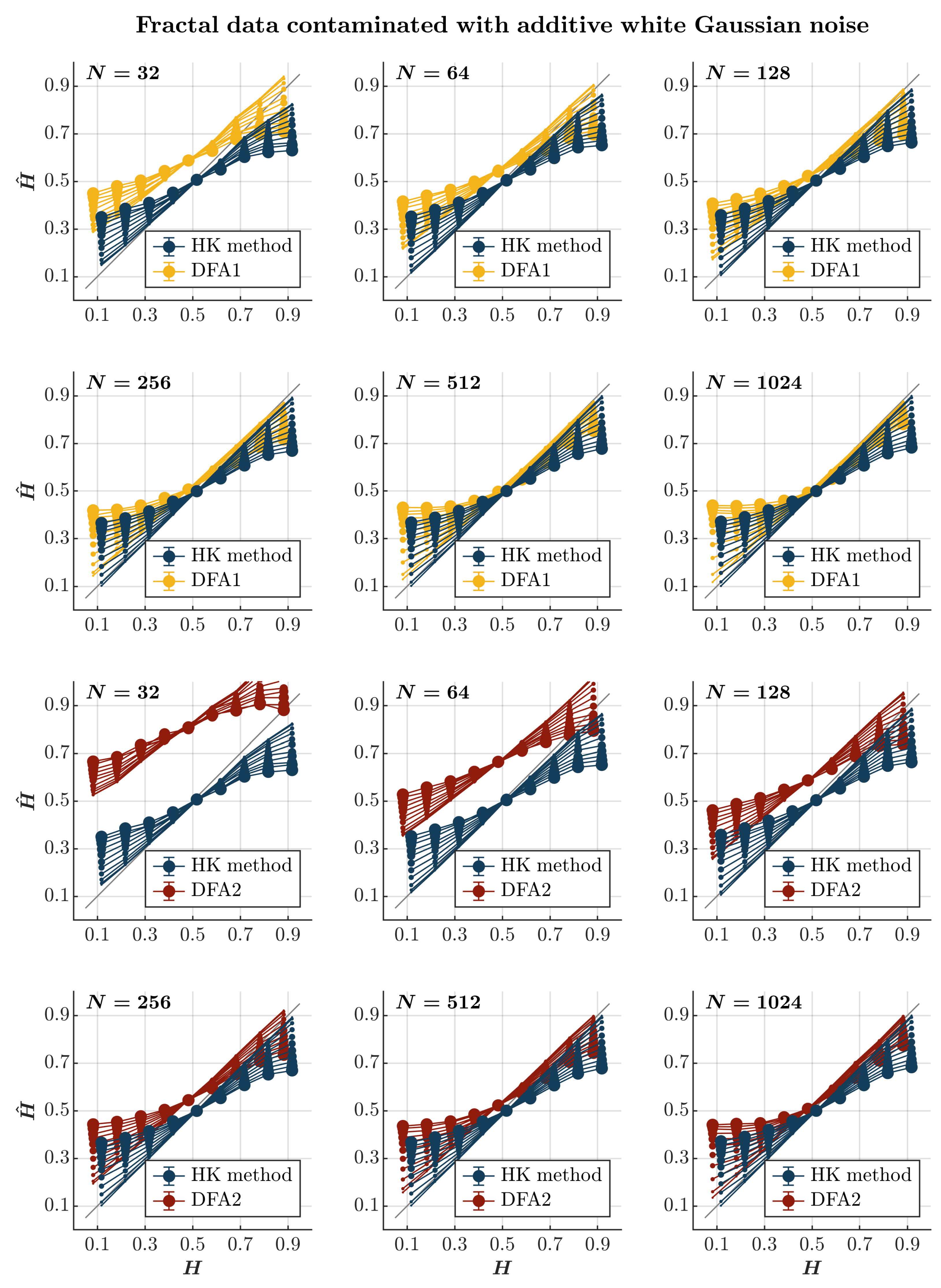
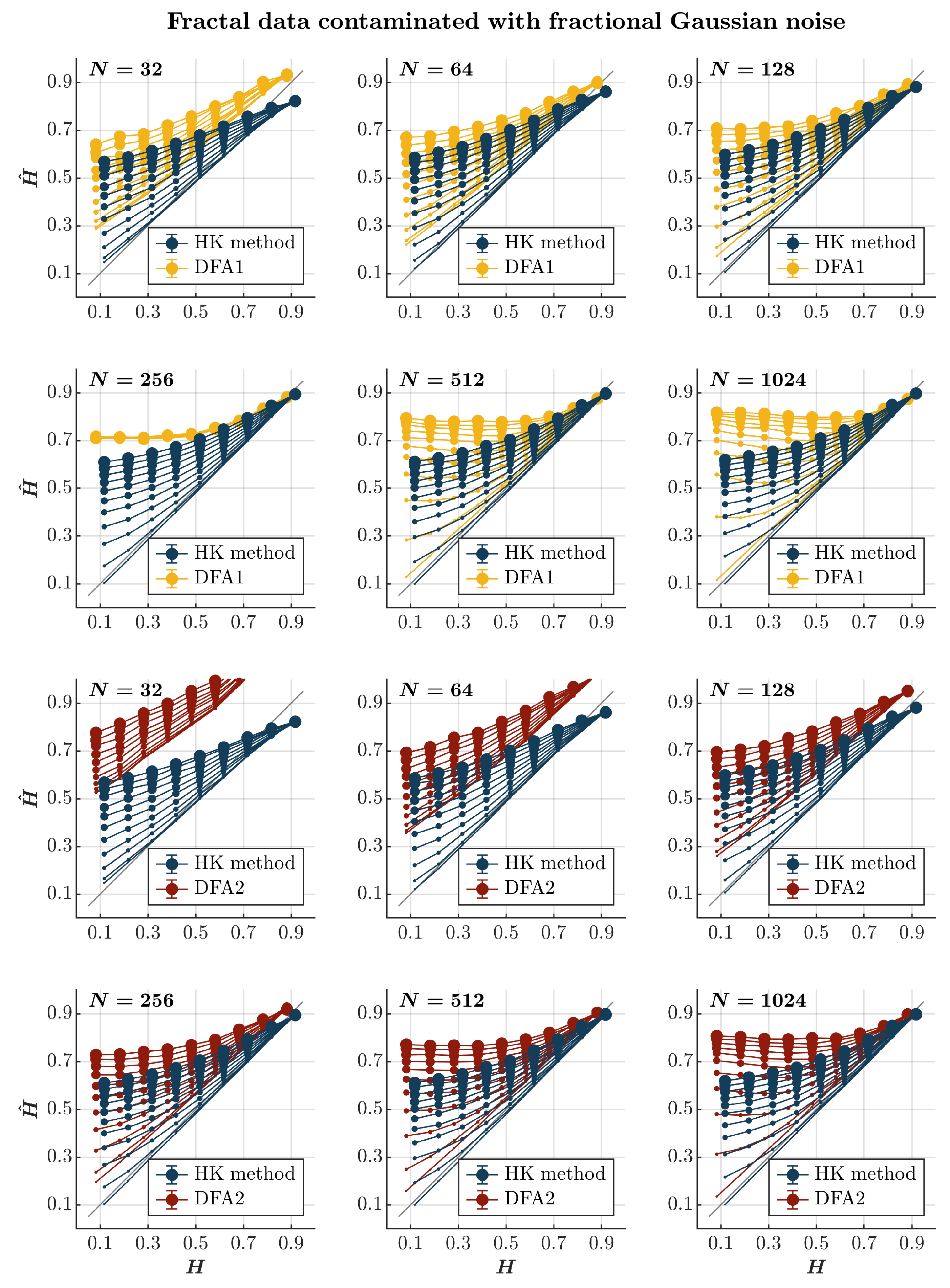

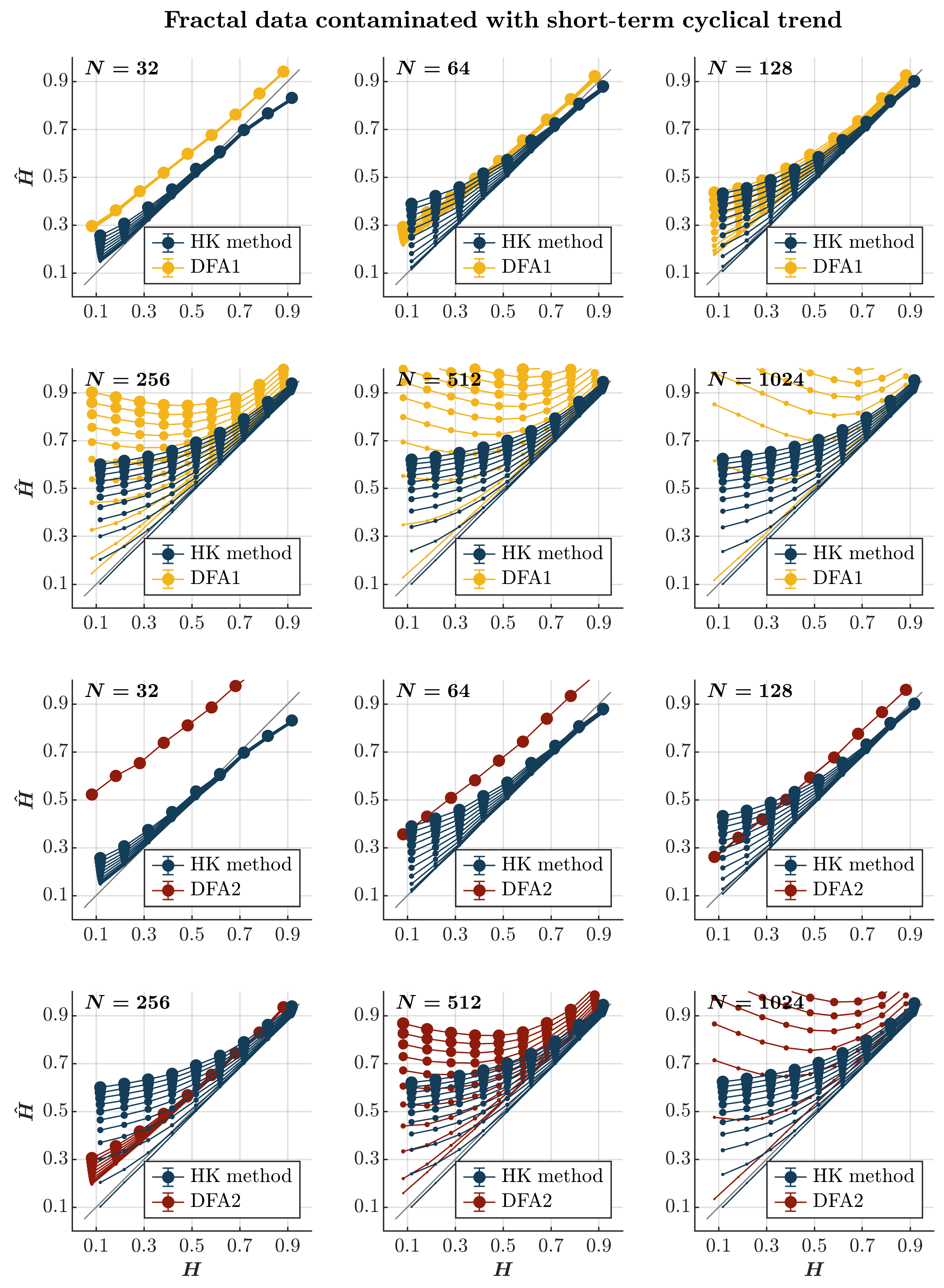
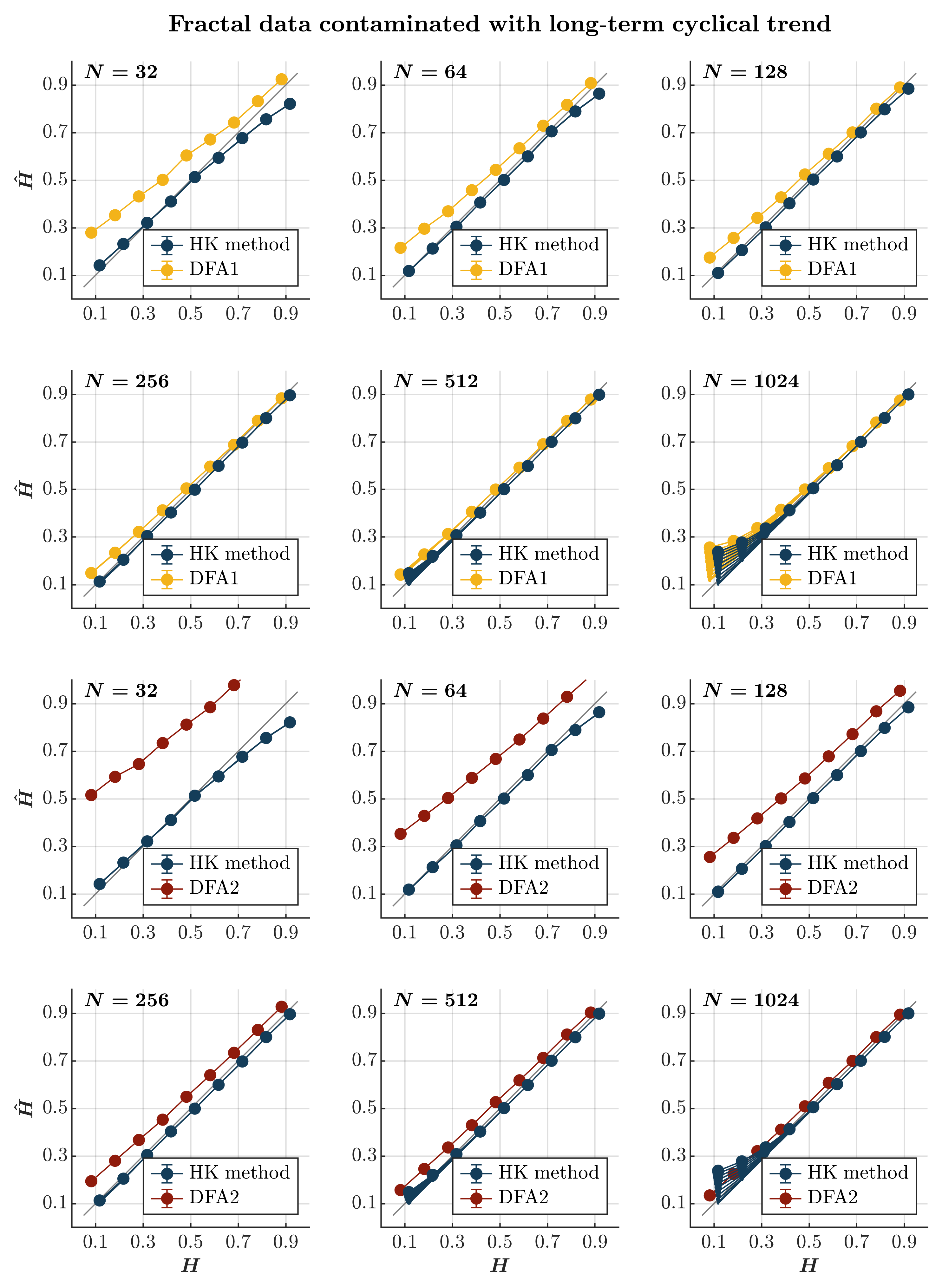
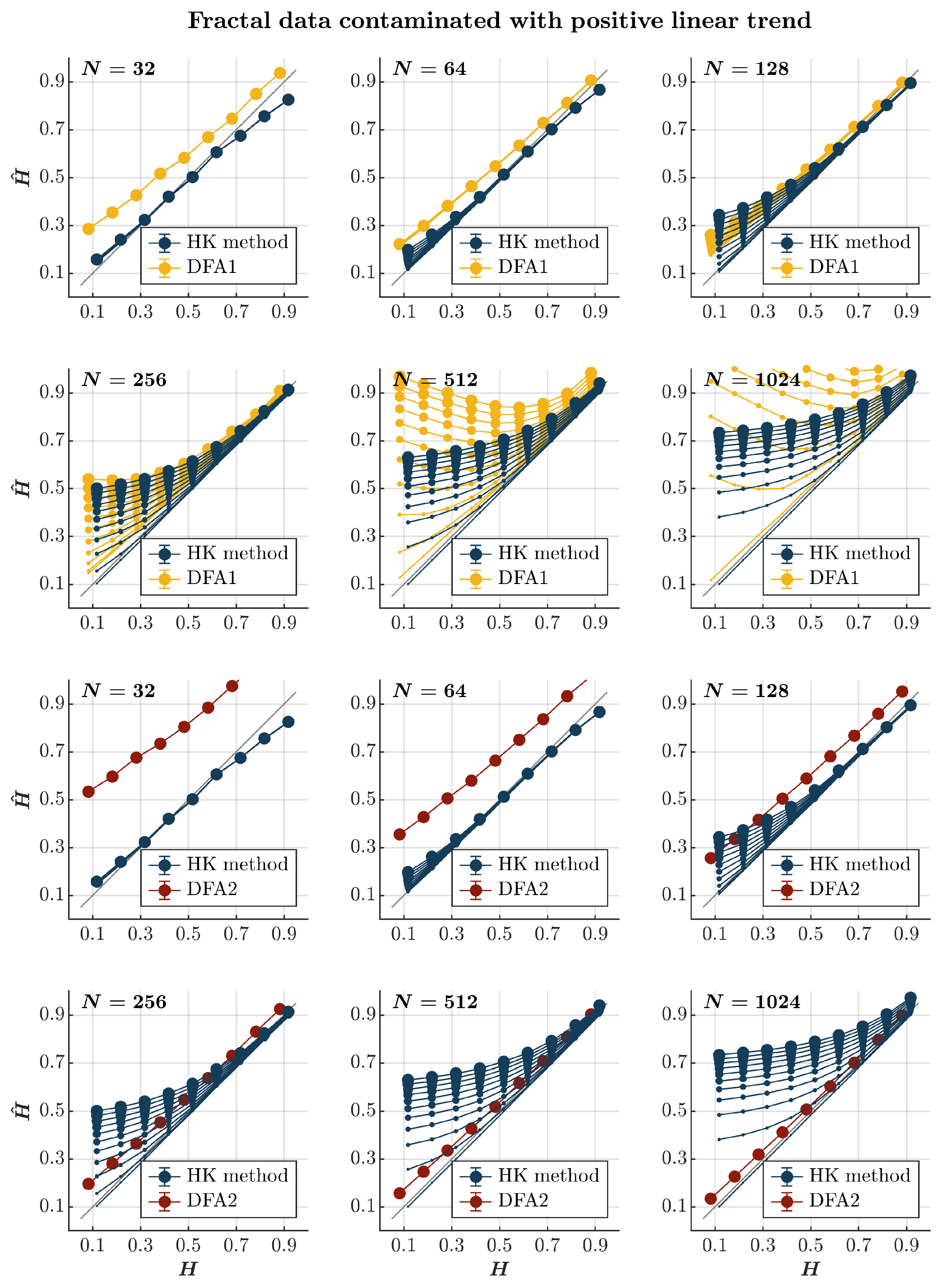
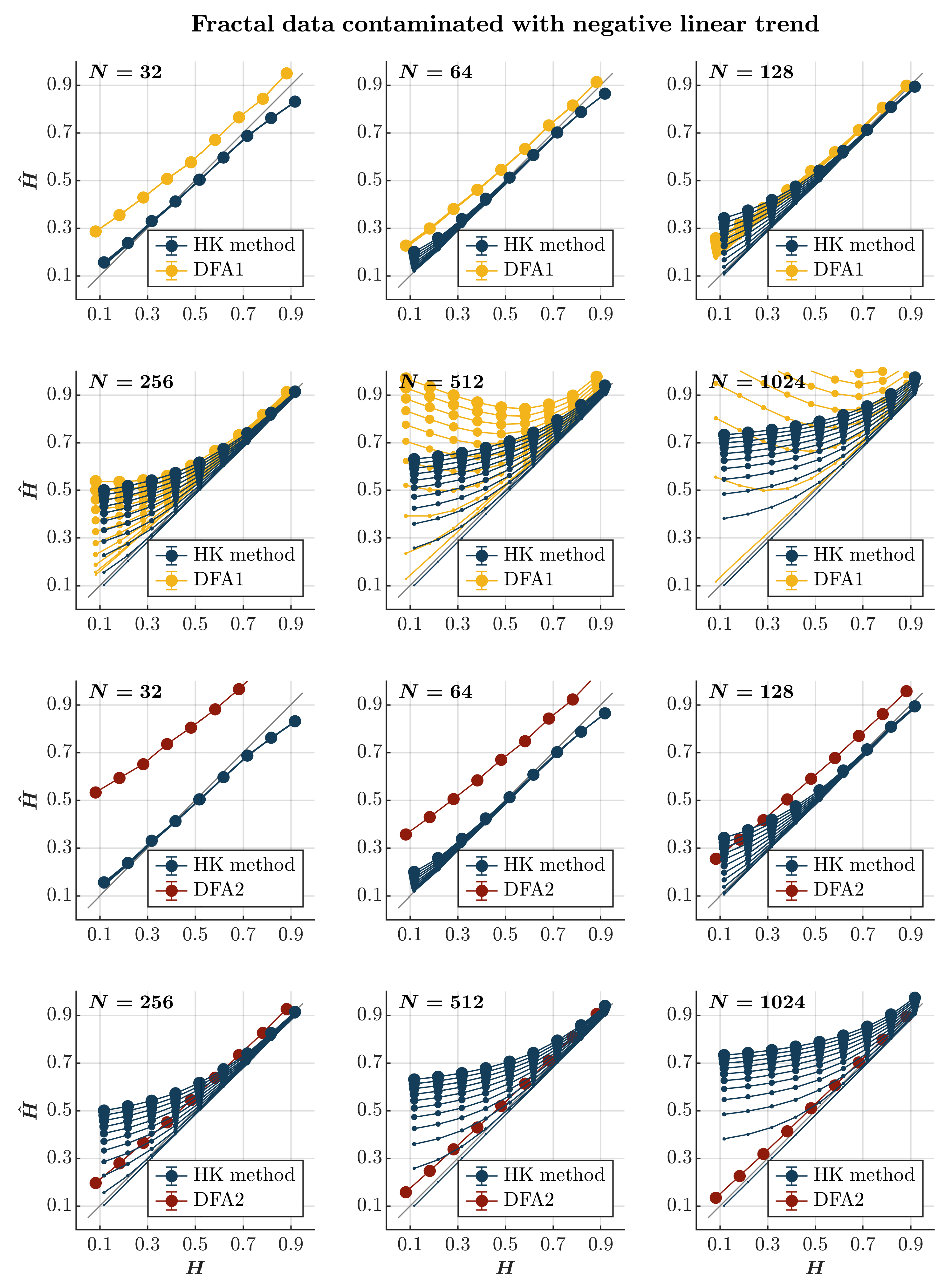

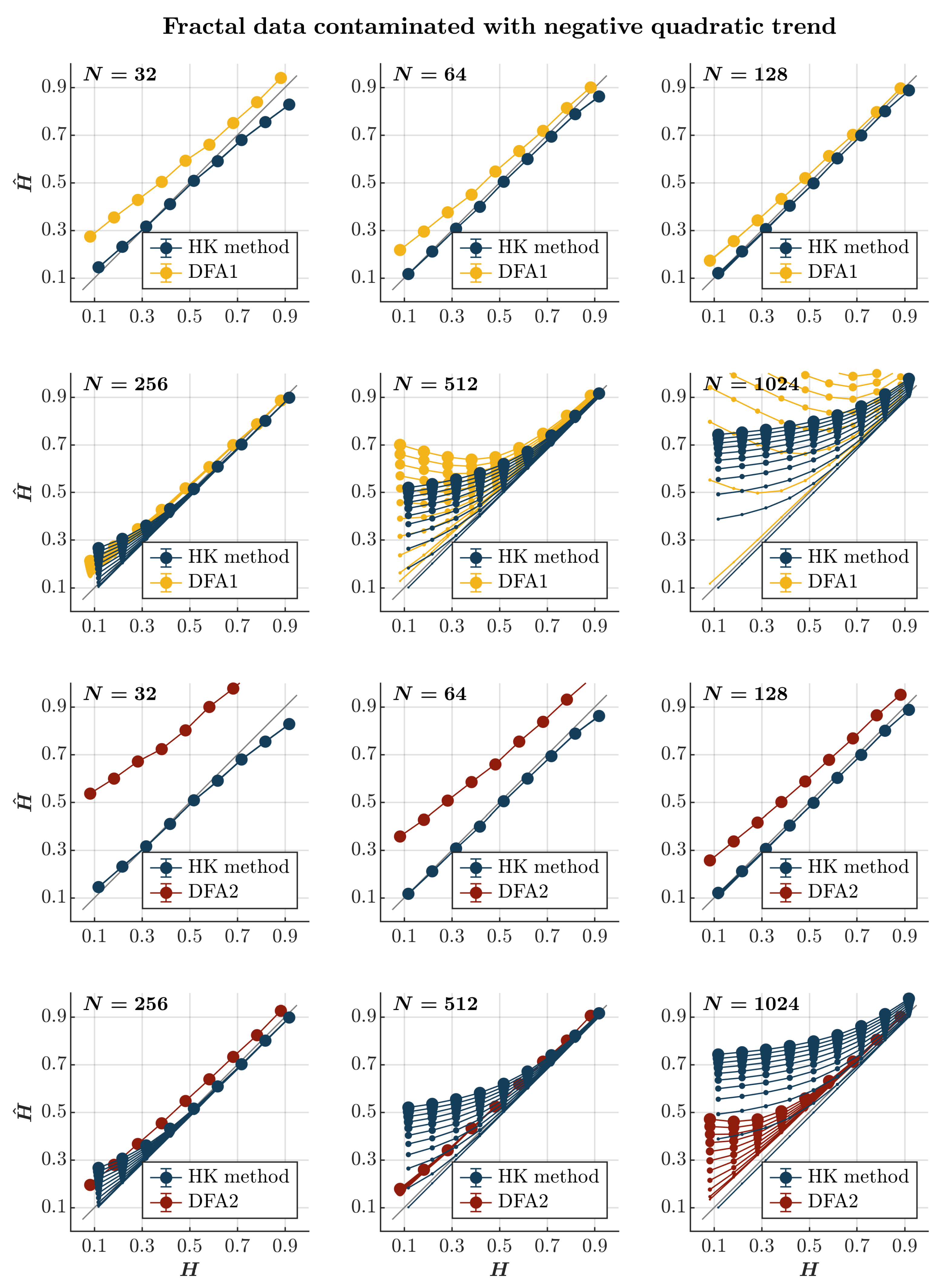
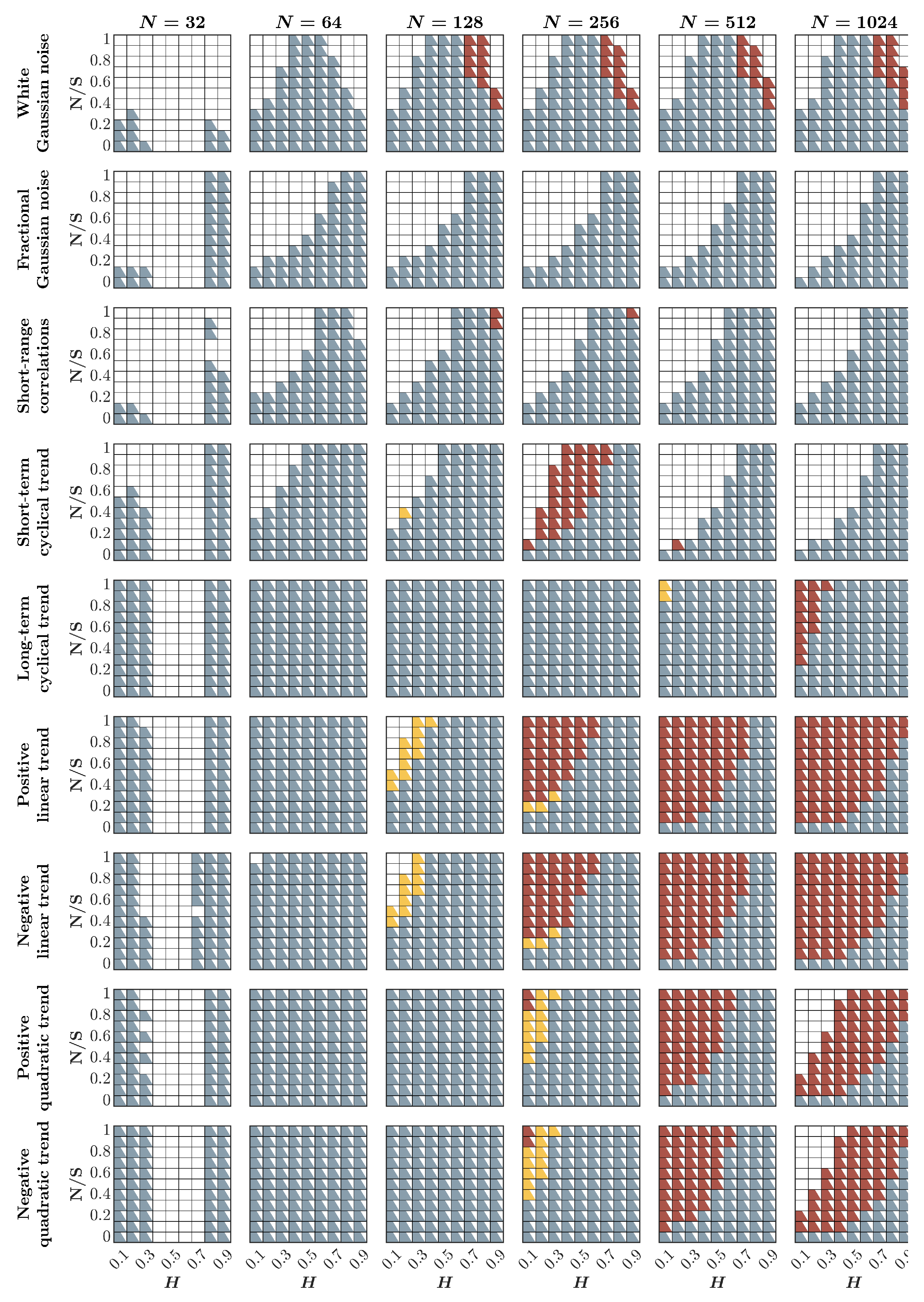
Disclaimer/Publisher’s Note: The statements, opinions and data contained in all publications are solely those of the individual author(s) and contributor(s) and not of MDPI and/or the editor(s). MDPI and/or the editor(s) disclaim responsibility for any injury to people or property resulting from any ideas, methods, instructions or products referred to in the content. |
© 2025 by the authors. Licensee MDPI, Basel, Switzerland. This article is an open access article distributed under the terms and conditions of the Creative Commons Attribution (CC BY) license (https://creativecommons.org/licenses/by/4.0/).
Share and Cite
Mangalam, M.; Likens, A.D. Precision in Brief: The Bayesian Hurst–Kolmogorov Method for the Assessment of Long-Range Temporal Correlations in Short Behavioral Time Series. Entropy 2025, 27, 500. https://doi.org/10.3390/e27050500
Mangalam M, Likens AD. Precision in Brief: The Bayesian Hurst–Kolmogorov Method for the Assessment of Long-Range Temporal Correlations in Short Behavioral Time Series. Entropy. 2025; 27(5):500. https://doi.org/10.3390/e27050500
Chicago/Turabian StyleMangalam, Madhur, and Aaron D. Likens. 2025. "Precision in Brief: The Bayesian Hurst–Kolmogorov Method for the Assessment of Long-Range Temporal Correlations in Short Behavioral Time Series" Entropy 27, no. 5: 500. https://doi.org/10.3390/e27050500
APA StyleMangalam, M., & Likens, A. D. (2025). Precision in Brief: The Bayesian Hurst–Kolmogorov Method for the Assessment of Long-Range Temporal Correlations in Short Behavioral Time Series. Entropy, 27(5), 500. https://doi.org/10.3390/e27050500





